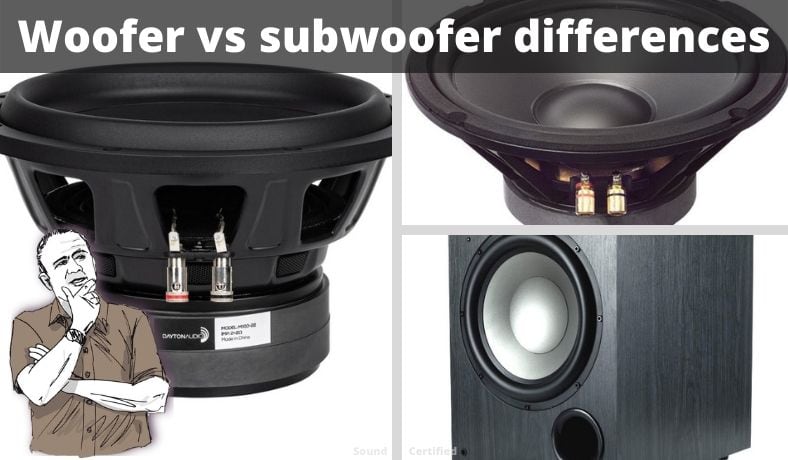Do you enjoy good bass, but are a bit confused on the benefits (and drawbacks) of a woofer vs subwoofer? You’re in the right place!
In this article, I’ll break down the differences, what you really need to know, and some other helpful facts that make a difference for good bass.
Contents
What is the difference between a woofer and a subwoofer?
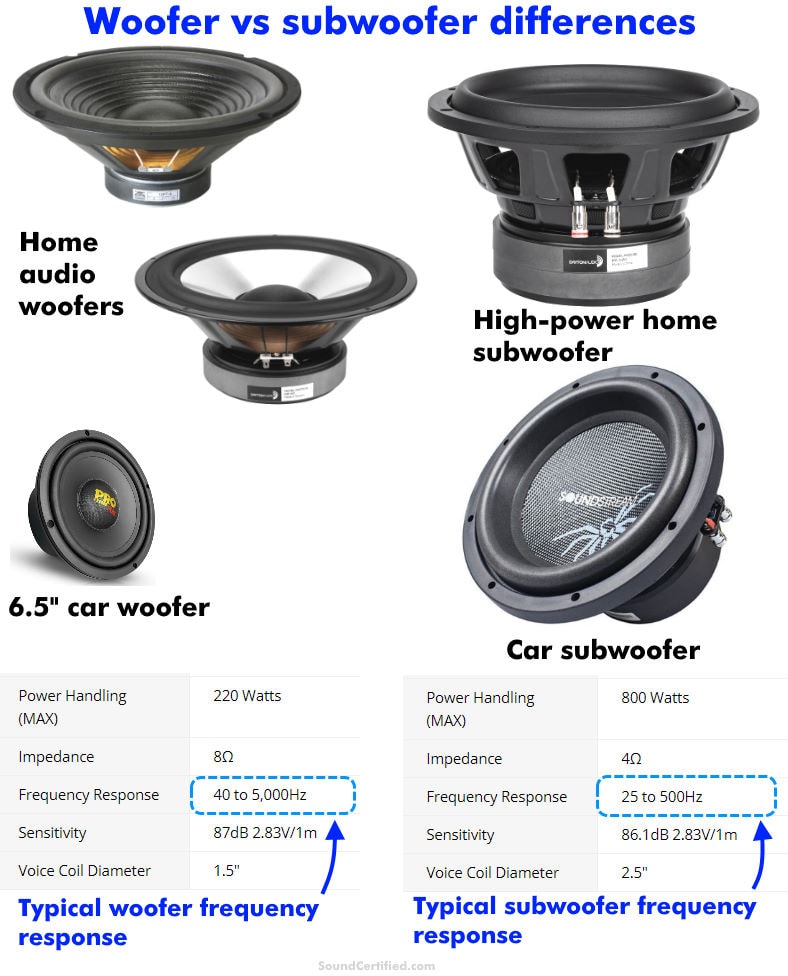
While they share a lot of similarities, the difference between a woofer and a subwoofer is that woofers typically have a wider frequency response to play both bass and mid range frequencies.
Subwoofers typically are used for low end, high-impact bass frequencies and often for high power levels.
Do subwoofers and woofers have different characteristics?
Yes, in many cases you’ll notice them right away. To clarify a bit, here are some woofer vs subwoofer characteristics:
- Woofers are usually part of a 2-way or 3-way speaker system, especially the main speakers for a home stereo. In this case, they produce a frequency range that includes both bass and midrange up to the tweeter’s cutoff frequency.
- Subwoofers are typically used alone in a sealed or ported enclosure designed only for low frequency audio. The frequency range they produce is often about 30 to 100Hz and they’re used to complement a full range sound system.
- Woofers tend to be more limited in their power handling, have a slightly different construction, and often use smaller magnets than subwoofers. Their cones also tend to be made from lighter materials than a subwoofer may use.
- A subwoofer’s excursion (range of cone motion it can tolerate) is often bigger than that of a traditional woofer. This allows them to handle slamming bass at higher power levels.
- Subwoofers often are built with voice coils that can handle higher power levels and vented subwoofer magnets with a “hole” (air vent) through the center to help keep the voice coil cool.
- Especially tough subwoofers may have a much larger & durable cone surround to make very high sound pressure levels possible.
- A subwoofer may also use larger speaker wire terminals for larger gauge wire and larger braided wire connected to the voice coils.
- Most woofers are not dual voice coil (DVC) while you can easily find dual voice coil subwoofers when shopping. They offer additional wiring configurations, configurable impedance, and share power handling between the coils.
- Subwoofers often have a thicker and stiffer cone than woofers in order to be able to produce extreme output levels when driven hard.
The wide range of subwoofer variants out there means you’re bound to find some that are essentially the same as a woofer.
Can a woofer be used as a subwoofer?
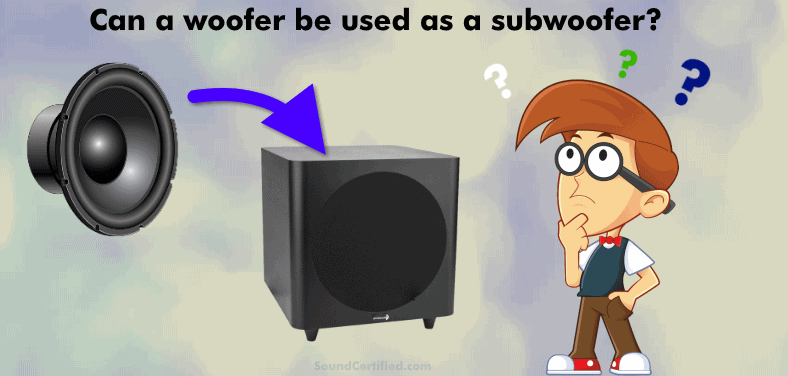
Yes, in many cases a subwoofer can be used as a subwoofer when a low pass crossover is used to limit its output to a lower frequency range.
The main thing (as is often the case) is that it depends on the particular speaker. Generally speaking, a woofer can be used alone in a sealed or ported box to create only pure bass.
Most of the time you won’t match the power handling of a dedicated subwoofer driver that’s designed to be pushed hard, but using a woofer for low frequency sound is actually pretty common with budget speaker system designs.
The low end frequency response of the woofer is what will determine how well it’ll do.
Powered subwoofer vs passive subwoofer differences
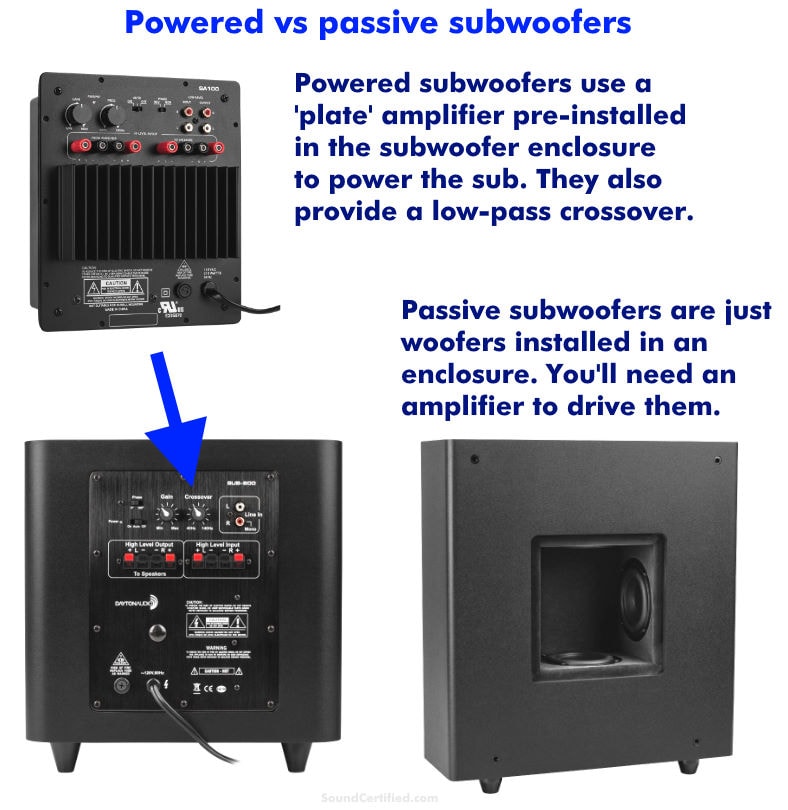
The difference between a powered sub (also called active subwoofer) and a passive sub is that a powered sub is a self-contained enclosure with an amplifier and low pass crossover preinstalled.
A passive sub, often pre-installed in an enclosure, requires an amplifier and crossover separately to work.
When is a powered subwoofer better than a passive subwoofer?
Powered subs are very common and useful in a wide variety of situations. Here’s a list of when or where they’re ideal:
- Home stereo systems and home theater systems often use an active subwoofer that work with a dedicated subwoofer output on the receiver. These are ready to go and deliver excellent bass sound out of the box.
- A car powered sub woofer is great for leased or temporarily used vehicles as they can often be removed easily and installed in another vehicle later.
- Many active subwoofers for cars and trucks are designed to be small enough to fit in small areas where passive sub systems can’t fit. Sometimes they’re the only way to get low-end sound.
- A powered sub is easy to swap out when you’d like to upgrade. For example, if your home theater system includes a 6.5″ subwoofer, you can simply buy an 8″ or 10″ powered subwoofer enclosure and swap it out in just a few minutes in most cases.
When is a passive subwoofer better than an active subwoofer?
- A passive sub is ideal when you have your own home or car amplifier and want control over the audio amplifier, crossover, power output, and more.
- Today you can buy ultra-slim (shallow mount) subwoofer drivers to use in very small boxes when space is tight. Although you can buy very compact powered sub systems, they usually have smaller speakers, meaning you’re more limited.
- Passive subs are used in super-powerful car audio speaker systems that can be driven with hundreds or thousands of watts and achieve high sound pressure levels (SPL). In that case, you’ll want to choose the amplifier used instead of being stuck with a weaker preinstalled one.
- A non-powered sub can be picked and matched with a used or budget amp if you’re tight on money. You can then later upgrade the speakers or amp if you like, unlike a powered system that isn’t designed to be opened and changed.
Like a lot of things, which works best for you in a given situation depends on what you’re after. For home stereo systems a powered sub is often plenty. It also eliminates the headache of getting a low pass crossover and the frequency cutoff is often adjustable.
A home audio system doesn’t have the losses and require nearly as much power for good sound as in a vehicle. A car subwoofer can require hundreds of watts to overcome road noise and a vehicle’s effect on sound inside.
Ported subwoofers and pros & cons vs a sealed subwoofer
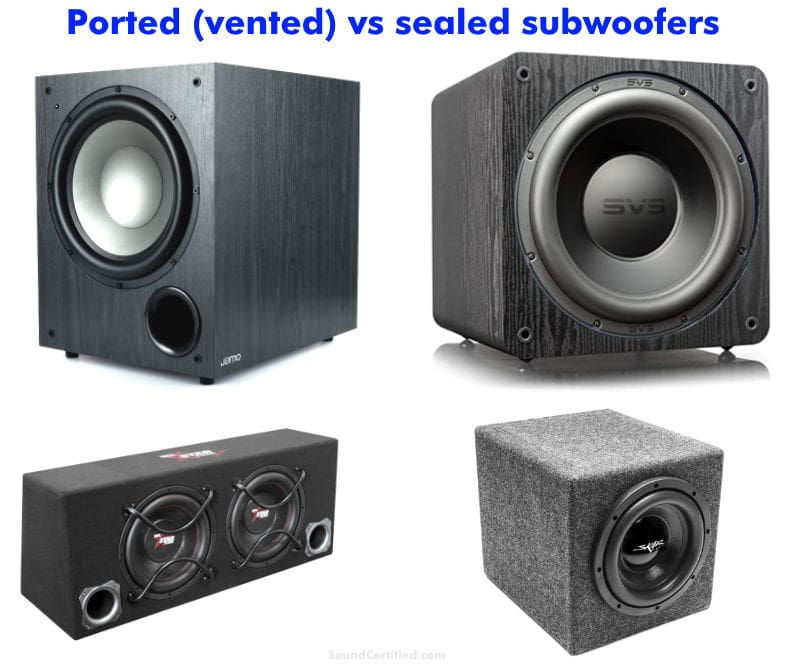
Ported subwoofer enclosures and sealed subs both have pros and cons – there’s not a “best” choice. What’s best is the one that will help you get the sound or performance you’re after.
Here are the main points to know.
Ported subwoofer pros & cons
- A ported/vented subwoofer box properly matched to the speaker can produce more sound output past a certain point. Vented enclosures are “tuned” to boost sound frequencies around a certain point based on the speaker driver’s parameters.
- A ported sub box can have more low-end extension, meaning the range of bass it can produce can be even lower than a sealed box.
- Ported boxes can help you get the most from the watts you paid for. That’s because at certain points in the frequency range they can produce a few more decibels (dB) of sound at the same power vs a sealed box.
- A speaker box that’s not a good match for the sub used can sound AWFUL. They can “flutter” and not produce the bass sound wave notes you’d expect, as well as bottom out early.
- Ported boxes are more complicated to design and build. They may require a computer design program to get right unlike simple sealed boxes. One reason is that the frequency it’s tuned for affects the port length and size.
- Ported subwoofer boxes don’t have the same “tight” bass that a sealed enclosure does. For sound quality enthusiasts, a sealed box is often a better choice.
Sealed subwoofer pros & cons
Pros:
- Sealed sub designs are fairly forgiving, meaning if the sub isn’t a great match for the box volume it can often still sound ok.
- A sealed sub box is easier and cheaper to produce. You can build your own at home pretty easily using a basic shape and some simple math.
- Good sealed boxes have accurate bass (“tight”) bass that is great for audiophiles and sound quality lovers.
Cons:
- Sealed car audio subwoofer boxes tend to be blander and have less cool-looking designs to choose from. For example, you can find boxes with single or multiple subwoofers and a plexiglass window, and even glow accent lighting!
- They use require more amp power to get the same sound pressure level (volume) as a good vented box.
When choosing between the two, it’s basically a trade based on what you’re after. Note that home theater systems often include a ported powered sub but in my experience they sound quite good.
Does a subwoofer cost more than a woofer?
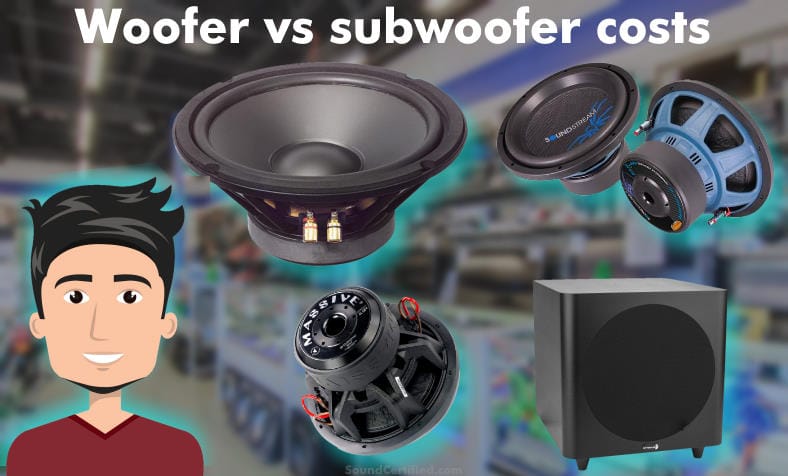
Generally speaking, average subwoofers and woofers cost around the same but it depends on the particular speaker. However, some super-powerful subwoofers with extreme designs are much more expensive than woofers.
For example, there are budget subwoofers for cars and home that are the same price as car and home woofers. There are also high-performance woofers that cost more than subs.
Similarly, there are high-performance subs that cost more than woofers both for car and home. The difference that comes into play is when looking at subwoofers designed to handle massive amounts of RMS power and sound, unlike woofers.
Those can cost hundreds of dollars and in some rare cases even more!
